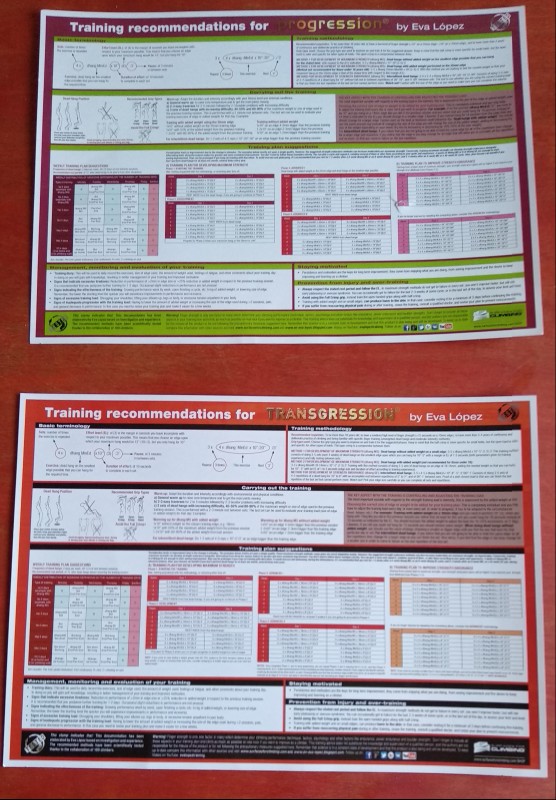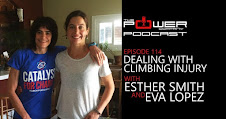Versión en español
As I promised Randy some time ago when responding to his comment -which was the starting point for this series-, we are going to look at some well known methods: statical-dynamical pull-ups and functional isometrics. And, shocker, this already long series will have one more entry (the 4th) that will suggest some specific exercises based on all the information gathered at this point. Afterwards, it will be you who will decide whether they are suitable for your needs, and how to incorporate them into your training.
 |
Ramón Julián at 2009 Arco Rock Master (Italy). Photo: Giulio Malfer. Fuente: rockmaster.com
|
This method was proposed in 1962 by Hoffman, and valued by authors like Giorgi et al. (1998), Fleck and Kraemer (2004), or Keogh et al. (1999). At the present there are a number of variations, using it by itself, or as part of a sequence of exercises in other method that we will discuss later and that has several different names: complex, combination training, contrast loading system, or contrast training
In their more basic form, they consist of a dynamic movement like a pull-up, followed by a maximum isometric contraction at the angle of maximum effort (Fleck and Kraemer, 2004).
 |
| A functional isometric set-up for bench press: Start the bar at a specific height, and lift it two to three inches against a second set of safety pins. Then hold the position for six to nine seconds. Keep on adding weight until you can't lift it. Just hold the bar firmly against the second set of safety pins for at least six seconds, while maintaining a good lifting posture. Source: www.t-nation.com |
The goal is to put the maximum resistance at the point where the joint has the least mechanical advantage or sticking point (Zatsiorsky and Kraemer, 2006), the underlying logic being that if we gain strength at the most difficult angle, we will experience an improvement along the whole range of movement. For example, there are two such points for the elbow flexors, at 170º and 50º, very similar to those for the triceps.
THE EFFECTS OF FUNCTIONAL ISOMETRICS ON TRAINED ATHLETES
Keogh et col. (1999) evaluated the effects of functional isometrics on trained subjects using the bench press (6RM that included a 2'' maximum isometric contraction at 160º), and compared it with other classic methods for 6RM, eccentric training and power exercises. The functional isometrics group of participants registered the highest values for the concentric phase when doing 1RM. This is in line with the work of Jackson el al. (1985), Giorgi et al. (1989) and O'Shea and O'Shea (1989), who suggested that this method could be useful for experienced and very strong subjects to improve on 1RM (RM = repetition maximum).
 |
| Jesús Beltrán "Brother". Photo: Javipec |
WHAT ABOUT THE LESS TRAINED ATHLETES?
For non-trained subjects the results are more varied. Gentil et col. (2006) found that 10 reps of 5-second maximal isometric leg extensions with a load that provoked muscle failure, induced a greater blood lactate accumulation and time under tension than the more traditional dynamic repetitions. This facts, according to some authors, is associated to an increase in muscle volume and maximum strength.
CONCLUSIONS AND RECOMMENDED EXERCISES
In my opinion, the key issue here is that, according to the mentioned studies, we should manage to apply, during each repetition, a maximum or near maximum load both in the concentric and the isometric phase. We usually can bear 10-15% more weight with an isometric contraction than with a concentric one; so, when we momentarily lock-off, we should add (don't ask me how right now) that 10-15% load. Later we will propose an exercise that can fullfill those requirements.
Complex training
The above mentioned combination (a.k.a. conjugated, combination, bulgarian, or contrast (Cometti, 2000) training, is based on the postactivation potentiation (PAP) effect that results from mixing light and heavy loads and different types of contraction during the same set or session (isometric and dynamic, for example). Given that the exercises must be executed at the maximum possible speed and that different intensities are used, there will be an increased dynamic power (Pmax) and rate of force development during the lighter load exercise. This would have in theory a positive effect on neural activation, power and therefore on maximum strength.
LOOKING AT THE EFFECTS
Research into complex training has been done from two perspectives: the acute, immediate benefits of performing a heavy strength exercise as a warm-up prior to a maximal power or speed performance (such as vertical jump test) and the long-term training adaptations that can be developed from a periodized complex training program.
Regarding acute effects in Some studies have evaluated how combination training affects performance of the upper limb in power exercises like throws; they suggest that it can be as, but no more, effective than other "traditional" methods for children, women and people with a low training level (Ebben, 2000).
Nonetheless, as was the case with the previous method, it can be more beneficial for men, and for those with a higher level of training (Ebben and Watts, 1998), possibly due to their higher percentage of fast twitch fibers (Hamada et al., 2000), and/or their superior maximum strength (Ebben, 2002).
French, Kraemer and Cook (2003) did a study with fourteen track and field athletes, and data indicate that performing a sequence of repeated maximal isometric knee extensions (3 repetitions of 3 seconds) prior to (30 minutes) selected dynamic exercise (0.25 seconds) may have favorable effects on performance beyond standards achieved without prior heavy loading. Lastly, it is interesting to note that the PAP ergogenic stimulus has been found to last between two-to-thirty minutes (Chiu, Fry, Weiss, et al. 2003; Rixon, Lamont, Bemden, 2007)
 |
| Luis Muñoz. Photo: Javipec |
THE STATIC-DYNAMIC METHOD
There's a class of combination trainings popular among climbers, the so called iso-dynamic by Verjoshansky (1986), or static-dynamic by Cometti (2000). Depending on the desired effects, they can also be called iso-miometric and iso-ballistic. Now, the most used variant among european climbers is the one described by Cometti, that in our case consists of mixing pull-ups and lock-offs like this:
An explosive pull-up is done up to certain angle, then a lock-off is maintained for certain amount of time, and finally the pulling movement is finished at high speed. The author suggests the use of 2-second lock-offs, and loads of about 60% of maximum concentric strength for the pull-ups. In this video there's an example (min 3:25 to 3:50).
STUDY OF THE EFFECTS
I couldn't find any studies that tested the effects of this exercise on pull-up maximum strength and power endurance, on power when doing more specific exercises like campus board, or general climbing performance.
In theory, given the similarity to the pulling-locking gesture so common in climbing, it coul be of some interest. But it remains to be seen what for and how to use it.
WHERE CAN THIS METHOD BE OF HELP?
Several facts must be taken into account before answering:
Obviously, the deceleration that occurs when we stop pulling and lock, clashes with the explosive pulling force that we were generating the moment before.
 |
| Lega on "Supertitte", Castillo de Bayuela (Toledo, Spain). Photo: Carles de Diego. Source: carlesdediego.blogspot.com |
 |
| Mery on "Valle de Rosas", 8a+, Cuenca (Spain). Photo: javipec |
So, especially for developing maximum strength (using more than 1RM), power, and power-endurance, the dynamic methods seem more effective when it comes to pulling; conversely, the static methods will be more suitable for maximum and explosive locking strength and locking power-endurance.
Nevertheless, there is an area where this method can be of help, and that is to improve our ability for swiftly and effectively transitioning from a dynamic contraction (pulling) to a static one (locking-off) and vice versa. Ability that, as we already know, is constantly demanded in our sport.
 |
| Oscar Martinez on "La Soucoupe", 7C+, Chironico (Switzerland). Photo: Joseba Saiz. Fuente: Oscar facebook profile |
Summing up, with the intention of setting priorities and choosing a training methodology for our planning, we could determine different training goals, or different effects to have in sight related to lock-off ability:
- Maximum locking strength
- Explosive locking strength
- Fast and effective transition form pulling to locking-off and vice versa
- Power-endurance specific to the pulling-locking gesture
 |
| This explosive isometric exercise consists of trying to push the bar against the stoppers, or pulling it, in an explosive way. Source: articleselitefts.com |
As stated by Verkhoshansky and Siff (2000) it would be very reductionist and wrong to define isometric contraction symply as one where a static muscle action takes place for certain amount of time. If we look at a graph showing how the force applied against an unmovable resistance until fatigue varies with time, we will see what is called the force-time (f-t) curve. The important word here is 'curve' and has several phases:
1- Force-generation or development phase: The muscle builds up tension until the Peak Maximum Force (PMF) is reached. It's been shown that this maximum isometric force takes at least 0,8 to 1 second.
Another remarkable aspect of this phase is that there is a moment, when the f-t curve is steepest, that is, the ratio between the force produced and the time to reach it is at its best. Such is the value for the maximum explosive force, the peak of force that has been achieved in the shortest possible time. This is around 30% of the PMF (max RFD in the graph below). Stone, Stone and Sands (2003) call "starting strength" the one that is applied during the first 30ms, and that determines the speed of the movement when we talk about a dynamic contraction. Do any of these figures remind you of the previous chapter?
3- Final or Force-decay phase: Reduction in force due to fatigue.
According to this, we find fast or explosive isometric contractions where the generation-force phase is short, and the force generated per unit of time (RFD or explosive force) is very high; the downside is that there is no time to reach our maximum strength (PMF). Reversely, in a slow or maximum isometric the explosive component is much lower, but we can reach our peak force. Using one or the other is not only a question of what method we use to solve a movement; many variables take part, like personal climbing style, wall angle, hold size, finger strength (if we can barely grab a hold, we don't have time to gather a lot of maximum pulling or locking strength), and even muscle composition and training habits.
 |
| RFD curve for fast or explosive isometrics versus slow or maximum isometrics |
 |
| Nacho Sanchez on Memento, 8C, Silvretta (Switzerland). Photo: Rebeca Morillo. Source: Nacho's blog |
But that, will be the topic of the next entry in the series.
LINKS RELATED
Lock-off Training in Sport Climbing (I). Does Static (lock-offs) Training have any Effect over Dynamic (pull-ups) Performance?
Lock-off Training in Sport Climbing (II) Does our locking-off ability have any influence on our performance? Is it so important to train it?
Lock-off Training in Sport Climbing (III) Do you really lock-off?
REFERENCES
- Cometti, G. (2000): Los métodos modernos de musculación. Paidotribo.
- Chiu, L.Z., Fry, A.C., Weiss, L.W., Schilling, B.K., Brown, L.E., & Smith, S.L. (2003). Postactivation potentiation response in athletic and recreationally trained individuals. Journal of Strength and Conditioning Research. 17(4), 671-677.
- Ebben, W. P., Watts, P. B., Jensen, R. L. and Blackard, D. O. (2000): EMG and kinetic analysis of complex training exercise variables. Journal of Strength and Conditioning Research 14(4), 451-456.
- Ebben, W. P. (2002): Complex training: A brief review. Journal of Sports Science and Medicine 1, 42-46
- Fleck SJ, Kraemer WJ (1997). Fleck SJ, Kraemer WJ (2004): Designing Resistance Training Programs, ed 2. Designing Resistance Training Programs. Human Kinetics Publishers
- French, DN, Kraemer, J, Cooke CB (2003) Changes in Dynamic Exercise Performance Following a Sequence of Preconditioning Isometric Muscle Actions. Journal in Strength and Conditioning Research, 17(4), 678-685
- Gentil, P., Oliveira, E., and Bottaro, M (2006): Time under Tension and Blood Lactate Response during Four Different Resistance Training Methods. Journal of Physiological Anthropology; 25(5): 339–344
- Giorgi A., Wilson GJ, Weatherby RP (1998) Functional isometric training: its effects on the development of muscular function and the endocrine system over an 8- week training period. Journal of Strength and Conditioning Research, 12, 18-25
- González Badillo JJ and Gorostiaga Ayestarán E. (1995) Fundamentos del entrenamiento de la fuerza. Aplicación al alto rendimiento deportivo. Zaragoza: INDE; 1995.
- Gonzalez Badillo and Ribas, J (1996): Fundamentos del entrenamiento de la fuerza. Inde
- González-Badillo, JJ, and Izquierdo, M. (2008): Evaluación de la fuerza en el control del entrenamiento y el rendimiento deportivo. In Izquierdo, M. (editor); Biomecánica y Bases Neuromusculares de la Actividad Física y el Deporte. Panamericana
- Hamada, T., Sale, D.G., MacDougall, J.D., and Tarnopolsky, M.A. (2000): Postactivation potentiation, fiber type, and twitch contraction time in human knee extensor muscles. J Appl Physiol, 88: 2131–2137
- Jackson, A.; Jackson, T., Hnatek, J., and West, J. (1985): Strength development: Using functional isometrics in an isotonic strength training program. Res. Q. Exerc. Sport, 56:234–237.
- Keogh, J.W.L., Wilson, G.J., and Weatherby, R.P. (1999): A Cross-Sectional Comparison of Different Resistance Training Techniques in the Bench Press. Journal of Strength and Conditioning Research, 13(3), 247–258
- O’Shea, K.L., and O’Shea, J.P. (1989): Functional isometric weight training: Its effects on dynamic and static strength.J. Appl. Sport Sci. Res.3(2):30–33
- Rixon, K.P., Lamont, H.S., and Bemden, M.G. (2007). Influence of type of muscle contraction, gender, and lifting experience on postactivation potentiation performance. Journal of Strength and Conditioning Research, 21(2), 500-505.
- Tihanyi J, Bosco C, Fekete G, and Apor G (1989) The effect of muscle structure and training conditions on the rate of torque development. Review of the Hungarian University of Physical Education, Budapest, 185-198
- Zatsiorsky VM, and Kraemer WJ (2004) Science and Practice of Strength Training-2nd edition. Human Kinetics
- Van Cutsem, M., and Duchateau, J. (2005). Preceding muscle activity influences motor unit discharge and rate of torque development during ballistic contractions in humans. The Journal of Physiology, 562(2), 635-644.
- Verkhoshansky, Y., and Siff, M. C. (2004). Superentrenamiento.Madrid. Paidotribo.

 A high and consistent execution level begins with the discovery of those factors and conditions that allow for a higher performance, or that, conversely, lead to an efficacy below our expectations (Harris, D. in Williams, 1991).
A high and consistent execution level begins with the discovery of those factors and conditions that allow for a higher performance, or that, conversely, lead to an efficacy below our expectations (Harris, D. in Williams, 1991).


 THOUGHTS ABOUT THE FUTURE/EXPECTATIONS
THOUGHTS ABOUT THE FUTURE/EXPECTATIONS
 When confronted by these four sources of stress, we have to realize that there are no psychics; we can’t be sure of what’s going to happen tomorrow, so let’s not make predictions. The past is already fixed, so we just have the present. We do have control over the here and now. Focus on it! Let’s center our attention on the present.
When confronted by these four sources of stress, we have to realize that there are no psychics; we can’t be sure of what’s going to happen tomorrow, so let’s not make predictions. The past is already fixed, so we just have the present. We do have control over the here and now. Focus on it! Let’s center our attention on the present.









 https://orcid.org/0000-0003-0304-5290
https://orcid.org/0000-0003-0304-5290







